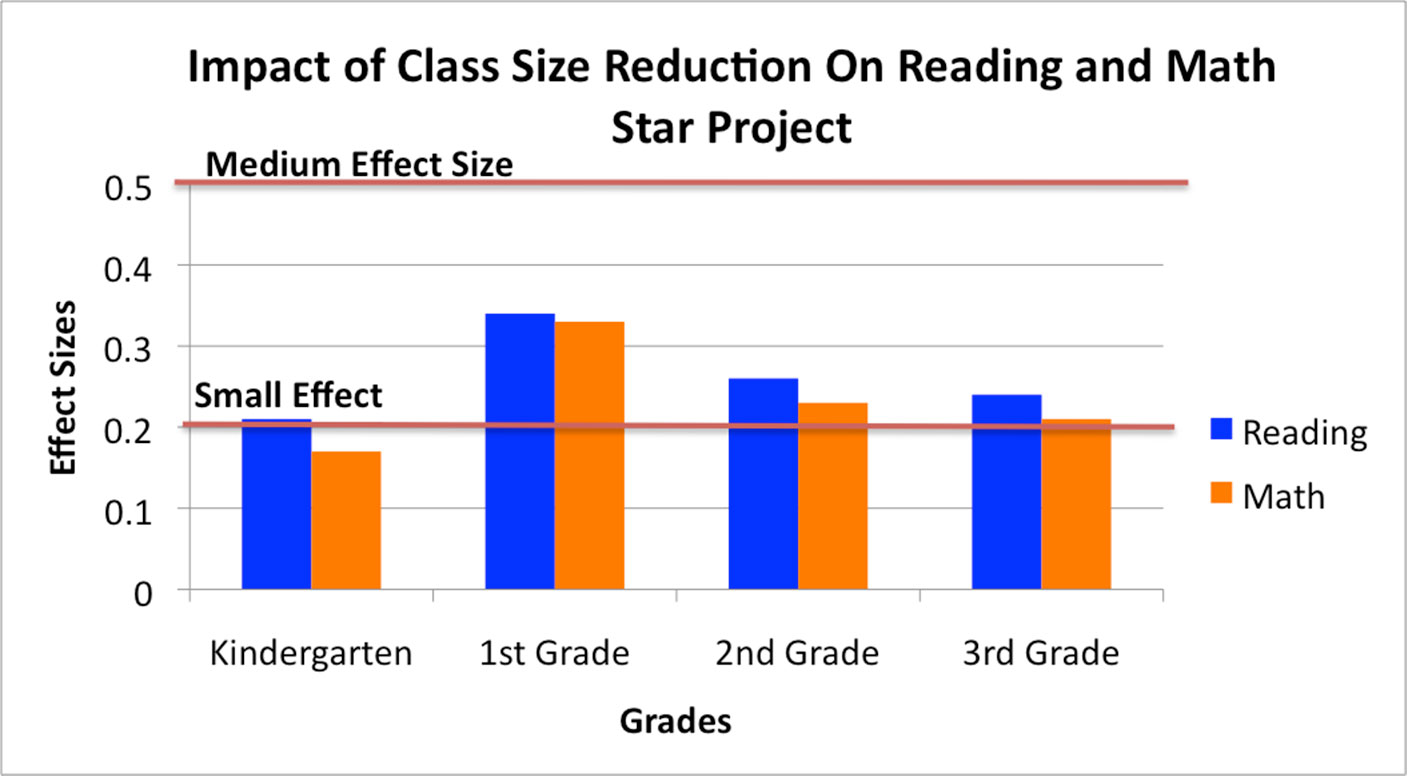What is the effect of class size reduction in a controlled study?
Why is this question important? Class size reduction has been one of the most thoroughly studied educational interventions to be taken to scale. The STAR Project, a randomized controlled study, was conducted in the 1980s in the state of Tennessee. The STAR Project and follow-up research, such as the Wisconsin Sage Project, greatly added to our knowledge base of the effects on student performance of reducing the number of students in a classroom. Relying upon this research, California decided to make class size reduction the centerpiece of its education reform efforts and implemented the initiative across the entire state. This sequence of events makes class size reduction a cautionary tale and provides an excellent example of how to navigate the challenges confronted when taking new practices from research to practice.
See further discussion below.

Source: The State of Tennessee's Student/Teacher Achievement Ratio (STAR) Project: K-3 Class Size Study
Results: The STAR Project established that class size reduction could be employed to improve student performance. In particular, small class size can produce increases in student achievement that are lasting. This was especially true for minority and low socio-economic (SES) students. The greatest gains were for children in the early grades. In each of the grades, kindergarten through third-grade students achieved higher scores in reading and math than students in larger classes. The effects after first grade declined slightly but remained significant through the end of third grade. The study also established that a classroom teacher was the critical person in the equation. Classrooms that relied on classroom aides to achieve the desired ratio did not experience the improvement in student achievement that came with a classroom teacher.
Implications: Implications that can be derived from the study are: (1) Students can make improvement in math and reading from placement in classes of 13 to 17 students. The optimal class size was not established by this study. (2) These results were most notable for SES and racial populations that participated in the study. (3) These results can be achieved when credentialed personnel teach. Comparable results cannot be achieved by substituting para-professionals for teachers as a less expensive alternative to boost ratios and save money. (4) Although it can be effective, class size reduction is expensive and should be weighed against available alternative interventions that can improve student performance for less money.
Taking Class Size Reduction to Scale in California notes, California's implementation of class size reduction did not match that of the experience of Tennessee. In California, the student achievement gains were minimal, improvement for low (SES) students did not occur as anticipated, and the costs of implementation had a major impact on the state's education budget.
Authors: Elizabeth Word, John Johnston, Helen Bain, B. Fulton, Jayne Zaharias, Charles Achilles, Martha Lintz, John Folger, and Carolyn Breda
Publisher: Tennessee State Department of Education
Study Description: The study was a large-scale, randomized controlled trial designed to assess the effects of class size reduction on student achievement. Approximately 11,600 students, 1,300 teachers, 76 schools, and 42 districts participated in the experiment. The study was structured to determine if students in classes consisting of 13 to 17 students would perform better than students in classes of 22 to 26 students. The student's achievement was assessed using standardized tests (Stanford Achievement Tests, or SAT) as well as the state's basic skills test of reading and math. The study was completed after following the students for four years.
Definitions:
- Class size: The ratio of classroom teacher to the total number of students in a specific classroom.
- Traditional classroom size: Classroom with a teacher-to-student ratio of 1 teacher to 22 to 26 students.
Related Research: Class Size Reduction in California: Early Evaluation Findings, 1996-98, Technical Report, June 1999, pg. xix, Fig. 7.
Citation: Word, E. R., Johnston, J., Bain, H. P., Fulton, B. D. et al. (1990), The State of Tennessee's student/teacher achievement ratio (STAR) Project, Technical Report 1985-90.
